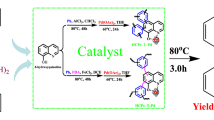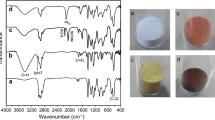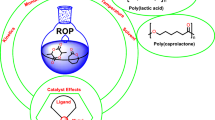Abstract
A series of model polymerization are carried out via the one-pot externally initiated Kumada catalyst-transfer polycondensation (KCTP) of 2-bromo-5-chloromagnesium thiophene monomers, and the excess amount of initiators or catalysts are found no need to be isolated during the polycondensation process. Especially, the impacts of the nickel catalyst loading variation on regioregularity (rr), yield, molecular weight (M n), polydispersity (PDI) and initiation efficiency of poly(3-hexylthiophene) (P3HT) are systematically investigated. The 1H NMR, size-exclusion chromatography (SEC), and MALDI-TOF mass spectroscopy results indicated that an excess amount of catalyst does not influence yield, rr, M n, and PDI of P3HT, nor the initiation efficiency. However, the PDI of the product is broad, and the M n and rr values decreased in the absence of 1,3-bis (diphenylphosphino)propane (dppp). It can be concluded that the in-situ KCTP polymerization of P3HT is a practical and effective process. These results are especially valuable for the synthesis of all-conjugated block copolymers where macroinitiators are used.
Similar content being viewed by others
References
Sheina E E, Liu J, Iovu M C, et al. Chain growth mechanism for regioregular nickel-initiated cross-coupling polymerizations. Macromolecules, 2004, 37(10): 3526–3528
Iovu M C, Sheina E E, Gil R R, et al. Experimental evidence for the quasi-“living” nature of the grignard metathesis method for the synthesis of regioregular poly(3-alkylthiophenes). Macromolecules, 2005, 38(21): 8649–8656
Yokoyama A, Miyakoshi R, Yokozawa T. Chain-growth polymerization for poly(3-hexylthiophene) with a defined molecular weight and a low polydispersity. Macromolecules, 2004, 37(4): 1169–1171
Miyakoshi R, Yokoyama A, Yokozawa T. Catalyst-transfer polycondensation. mechanism of Ni-catalyzed chain-growth polymerization leading to well-defined poly(3-hexylthiophene). Journal of the American Chemical Society, 2005, 127(49): 17542–17547
Osaka I, McCullough R D. Advances in molecular design and synthesis of regioregular polythiophenes. Accounts of Chemical Research, 2008, 41(9): 1202–1214
Kiriy A, Senkovskyy V, Sommer M. Kumada catalyst-transfer polycondensation: mechanism, opportunities, and challenges. Macromolecular Rapid Communications, 2011, 32(19): 1503–1517
Liu J, Sheina E, Kowalewski T, et al. Tuning the electrical conductivity and self-assembly of regioregular polythiophene by block copolymerization: nanowire morphologies in new di- and triblock copolymers. Angewandte Chemie International Edition, 2002, 41(2): 329–332
Miyakoshi R, Yokoyama A, Yokozawa T. Synthesis of poly(3-hexylthiophene) with a narrower polydispersity. Macromolecular Rapid Communications, 2004, 25(19): 1663–1666
Liu J, McCullough R D. End group modification of regioregular polythiophene through postpolymerization functionalization. Macromolecules, 2002, 35(27): 9882–9889
Javier A E, Varshney S R, McCullough R D. Chain-growth synthesis of polyfluorenes with low polydispersities, block copolymers of fluorene, and end-capped polyfluorenes: toward new optoelectronic materials. Macromolecules, 2010, 43(7): 3233–3237
Huang L, Wu S, Qu Y, et al. Grignard metathesis chain-growth polymerization for polyfluorenes. Macromolecules, 2008, 41(22): 8944–8947
Miyakoshi R, Shimono K, Yokoyama A, et al. Catalyst-transfer polycondensation for the synthesis of poly(p-phenylene) with controlled molecular weight and low polydispersity. Journal of the American Chemical Society, 2006, 128(50): 16012–16013
Yokoyama A, Kato A, Miyakoshi R, et al. Precision synthesis of poly(N-hexylpyrrole) and its diblock copolymer with poly(p-phenylene) via catalyst-transfer polycondensation. Macromolecules, 2008, 41(20): 7271–7273
Senkovskyy V, Tkachov R, Komber H, et al. Chain-growth polymerization of unusual anion-radical monomers based on naphthalene diimide: a new route to well-defined n-type conjugated copolymers. Journal of the American Chemical Society, 2011, 133(49): 19966–19970
Sontag S K, Marshall N, Locklin J. Formation of conjugated polymer brushes by surface-initiated catalyst-transfer polycondensation. Chemical Communications, 2009, 45(23): 3354–3356
Senkovskyy V, Khanduyeva N, Komber H, et al. Conductive polymer brushes of regioregular head-to-tail poly(3-alkylthiophenes) via catalyst-transfer surface-initiated polycondensation. Journal of the American Chemical Society, 2007, 129(20): 6626–6632
Khanduyeva N, Senkovskyy V, Beryozkina T, et al. Grafting of poly(3-hexylthiophene) from poly(4-bromostyrene) films by Kumada catalyst-transfer polycondensation: revealing of the composite films structure. Macromolecules, 2008, 41(20): 7383–7389
Khanduyeva N, Senkovskyy V, Beryozkina T, et al. Surface engineering using Kumada catalyst-transfer polycondensation (KCTP): preparation and structuring of poly(3-hexylthiophene)-based graft copolymer brushes. Journal of the American Chemical Society, 2009, 131(1): 153–161
Doubina N, Jenkins J L, Paniagua S A, et al. Surface-initiated synthesis of poly(3-methylthiophene) from indium tin oxide and its electrochemical properties. Langmuir, 2012, 28(3): 1900–1908
Senkovskyy V, Beryozkina T, Bocharova V, et al. A core-first preparation of poly(3-alkylthiophene) stars. Macromolecular Symposia, 2010, 291-292(1): 17–25
Bronstein H A, Luscombe C K. Externally initiated regioregular P3HT with controlled molecular weight and narrow polydispersity. Journal of the American Chemical Society, 2009, 131(36): 12894–12895
Smeets A, Van den Bergh K, De Winter J, et al. Incorporation of different end groups in conjugated polymers using functional nickel initiators. Macromolecules, 2009, 42(20): 7638–7641
Okamoto K, Luscombe C K. Controlled polymerizations for the synthesis of semiconducting conjugated polymers. Polymer Chemistry, 2011, 2(11): 2424–2434
Yuan M, Okamoto K, Bronstein H A, et al. Constructing regioregular star poly(3-hexylthiophene) via externally initiated Kumada catalyst-transfer polycondensation. ACS Macro Letters, 2012, 1(3): 392–395
Wang J, Lu C, Mizobe T, et al. Synthesis and characterization of all-conjugated graft copolymers comprised of n-type or p-type backbones and poly(3-hexylthiophene) side chains. Macromolecules, 2013, 46(5): 1783–1793
Wang J, Ueda M, Higashihara T. Synthesis of all-conjugated donor-acceptor-donor ABA-type triblock copolymers via Kumada catalyst-transfer polycondensation. ACS Macro Letters, 2013, 2(6): 506–510
Wang J, Higashihara T. Synthesis of all-conjugated donor-acceptor block copolymers and their application in all-polymer solar cells. Polymer Chemistry, 2013, 4(22): 5518–5526
Doubina N, Ho A, Jen A K, et al. Effect of initiators on the Kumada catalyst-transfer polycondensation reaction. Macromolecules, 2009, 42(20): 7670–7677
Senkovskyy V, Sommer M, Tkachov R, et al. Convenient route to initiate Kumada catalyst-transfer polycondensation using Ni (dppe)Cl2 or Ni(dppp)Cl2 and sterically hindered grignard compounds. Macromolecules, 2010, 43(23): 10157–10161
Doubina N, Stoddard M, Bronstein H A, et al. The effects of binding ligand variation on the nickel catalyzed externally initiated polymerization of 2-bromo-3-hexyl-5-iodothiophene. Macromolecular Chemistry and Physics, 2009, 210(22): 1966–1972
Bilbrey J A, Sontag S K, Huddleston N E, et al. On the role of disproportionation energy in Kumada catalyst-transfer polycondensation. ACS Macro Letters, 2012, 1(8): 995–1000
Wong M, Hollinger J, Kozycz L M, et al. An apparent sizeexclusion quantification limit reveals a molecular weight limit in the synthesis of externally initiated polythiophenes. ACS Macro Letters, 2012, 1(11): 1266–1269
Koch F P V, Smith P, Heeney M. “Fibonacci’s route” to regioregular oligo(3-hexylthiophene)s. Journal of the American Chemical Society, 2013, 135(37): 13695–13698
Author information
Authors and Affiliations
Corresponding author
Rights and permissions
About this article
Cite this article
Wang, J., Higashihara, T. Effects of catalyst loading amount on the synthesis of poly(3-hexylthiophene) via externally initiated Kumada catalyst-transfer polycondensation. Front. Mater. Sci. 8, 383–390 (2014). https://doi.org/10.1007/s11706-014-0261-9
Received:
Accepted:
Published:
Issue Date:
DOI: https://doi.org/10.1007/s11706-014-0261-9




